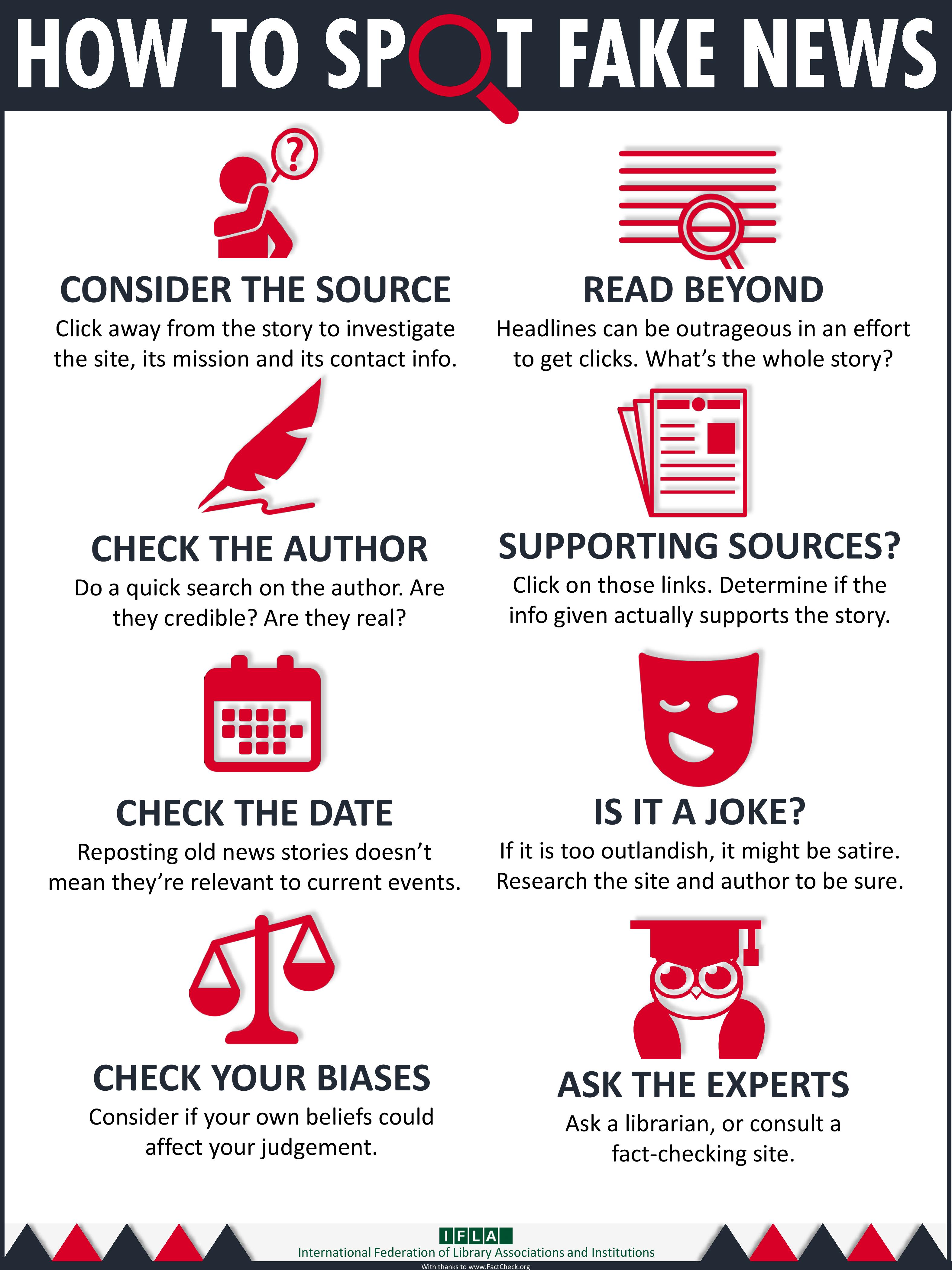
- PVCC Jessup Library
- Jessup Playbooks
- Media Literacy Modules
- Identifying Fake News
Looking for sources? Search EBSCO or QuickSearch.
Media Literacy Modules
These modules support faculty who wish to integrate media literacy into their courses, regardless of discipline.
Need Help?
Ask a Librarian @
Betty Sue Jessup Library
501 College Drive
Charlottesville, VA 22902
434.961.5309
reference@pvcc.edu
Betty Sue Jessup Library
501 College Drive
Charlottesville, VA 22902
434.961.5309
reference@pvcc.edu
Module Outcomes
After completing this module, students will be able to:
- apply various fact-checking techniques
- identify fake news sources
Readings
Identifying Fake News
-
6 Tips to Debunk Fake News Stories by YourselfBy Alexios Mantzarlis, Poynter Institute
-
Are These Stories True? (Nope): Fake-News Sites Get Rich by Lying to You. Here's What You Can Do About It.By Kristin Lewis and Adee Braun, from Scholastic Scope, May 2017, vol. 65, issue 8.
-
Fake Or Real? How To Self-Check The News And Get The FactsBy Wynne Davis, from NPR
-
How to Recognize Fake New SeriesFrom Films on Demand
-
How to Spot Fake NewsFrom FactCheck.org, a project of the Annenberg Public Policy Center
-
PolitiFact's Guide to Fake News Websites and What They Peddleby Joshua Gillin, from PunditFact
-
Understanding the Fake News Universe: A Guide to Fake News Terminologyby Media Matters for America
-
What Is Fake News? How to Spot It and What You Can Do to Stop Itfrom the Guardian
How to Spot Fake News
How to Spot Fake News - FactCheck.org
Tips!

- Approach news sources with a healthy level of skepticism, but not paranoia.
- Read! A lot...Are other news outlets reporting on the story?
- When you evaluate a news story, read laterally! This can save you a lot of time!
- If you primarily read news through social media platforms, beware. You are in an echo chamber. Read a variety of perspectives so you don't just read those articles that align with and confirm your confirmation bias.
- Check out the sources for yourself. Watch the video or read the statement, and double check for any editing or alterations.
- Don't share stories through social media without attempting to validate the story's legitimacy.
- Checking for validity is easy when you use the fact-checking sources below.
- Familiarize yourself with fake or biased news sites. Here is a list of biased news sites, compiled by Melissa Zimdars.
Fact Checking Tools
-
AP Fact CheckFact-checking and accountability journalism from AP journalists around the globe.
-
FactCheck.org"A nonpartisan, nonprofit “consumer advocate” for voters that aims to reduce the level of deception and confusion in U.S. politics. We monitor the factual accuracy of what is said by major U.S. political players in the form of TV ads, debates, speeches, interviews and news releases. Our goal is to apply the best practices of both journalism and scholarship, and to increase public knowledge and understanding. FactCheck.org is a project of the Annenberg Public Policy Center of the University of Pennsylvania."
-
Media Bias/Fack CheckMedia Bias/Fact Check (MBFC News) is an independent online media outlet. MBFC News is dedicated to educating the public on media bias and deceptive news practices. MBFC News’ aim is to inspire action and a rejection of overtly biased media. We want to return to an era of straight forward news reporting.
-
Politifact"PolitiFact is a fact-checking website that rates the accuracy of claims by elected officials and others who speak up in American politics. PolitiFact is run by editors and reporters from the Tampa Bay Times, an independent newspaper in Florida, as is PunditFact, a site devoted to fact-checking pundits."
-
SnopesA "reference source for urban legends, folklore, myths, rumors, and misinformation."
-
Washington Post Fact CheckerThe purpose of this website, and an accompanying column in the Sunday print edition of The Washington Post, is to “truth squad” the statements of political figures regarding issues of great importance, be they national, international or local.
Example Assignments/Lesson Plans
-
Center for News Literacy Curriculum ToolboxStony Brook University School of Journalism
-
Factitious, Pandemic EditionA quiz that tests your news sense.
-
Faked Outfrom PunditFact
-
Lesson Plan: Fighting Fake NewsFrom the Lowdown: Connecting Newsroom to Classroom, a KQED Learning Project
-
Making Sense of the News: News Literacy Lessons for Digital CitizensThis six-week course will help learners develop their critical thinking skills to enable them to better identify reliable information in news reports and to become better informed about the world in which we live. The course will discuss the key elements of journalism from the viewpoint of the news audience.
-
The Sift from the News Literacy ProjectSubscribe to The Sift, a weekly news literacy digest for teachers, from the News Literacy Project. Example assignments are provided each week.
